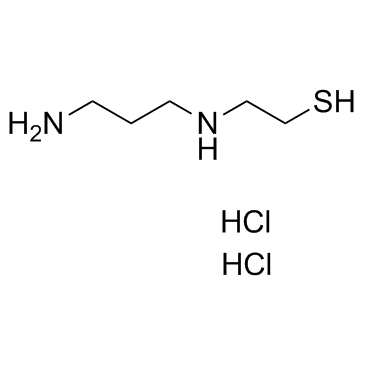14653-77-1
| Name | Amifostine Thiol Dihydrochloride |
|---|---|
| Synonyms |
Ethanethiol, 2-[(3-aminopropyl)amino]-, hydrochloride (1:1)
2-(3-aminopropylamino)ethanethiol,dihydrochloride 2-[(3-Aminopropyl)amino]ethanethiol hydrochloride (1:1) 2-[(3-Aminopropyl)amino]ethanethiol dihydrochloride WR-1065 dihydrochloride WR-1065 dihydrochloride |
| Description | WR-1065 dihydrochloride can protect normal tissues from the toxic effects of certain cancer drugs and activate p53 through a JNK-dependent signaling pathway. |
|---|---|
| Related Catalog | |
| Target |
p53[1] |
| In Vitro | The DNA-binding activity is increased in a WR-1065 dihydrochloride (WR-1065) concentration-dependent manner. Cells treated with 1 mM WR-1065 dihydrochloride for 24 h reveal that all of the p53-induced genes analyzed are transactivated following WR-1065 dihydrochloride treatment, in a p53-dependent manner. Significantly, treatment with WR-1065 dihydrochloride leads to a 3-fold increase in luciferase expression driven by AP-1, and a 5-fold increase when this reporter gene is driven by NF-κB, when these values are normalized to the level of the cotransfected β-galactosidase gene[2]. |
| In Vivo | The results show that wR-1065 dihydrochloride (WR-1065) attenuates the severity of 6-OHDA-induced catalepsy (P<0.001) when compare with 6-OHDA-lesioned rats. Also it has been observed that WR-1065 dihydrochloride improves catalepsy in dose dependent manner (P<0.001). Pretreatment with three different doses of WR-1065 dihydrochloride (20, 40 and 80 μg/2 μL/rat) for 3 days before 6-OHDA administration, significantly (P<0.001) elevates SOD activity and restores it to normal range compare with 6-OHDA lesioned rats[3]. |
| Kinase Assay | For Western analysis, cells are treated with 1 mM WR-1065 dihydrochloride (WR-1065) for 24 h, and subconfluent cultures of cells are harvested and lysed in RIPA buffer supplemented with protease inhibitors. Protein concentrations are determined by a detergent-compatible assay. Western blots are blocked and incubated in antibody in PBS/0.2% Tween 20/5% nonfat dry milk. Blots are incubated with 1 μg/mL antibody for 1 h at room temperature, followed by washing in PBS/0.2% Tween 20 and incubation in peroxidase-conjugated secondary antibody and chemiluminescence detection[2]. |
| Cell Assay | To test the effects of paclitaxel in the presence or absence of WR-1065 dihydrochloride (WR-1065) on cell growth, cells are seeded in 96-well tissue culture dishes at 20% confluence and allowed to attach and recover for at least 24 h. Varying combinations of paclitaxel alone or in combination with a 60 min pretreatment with 1 mM WR-1065 dihydrochloride are then added to each well, and the plates are incubated for an additional 48 h or 72 h. The number of surviving cells is determined by staining. The percentage of cells killed by paclitaxel and/or WR-1065 dihydrochloride is calculated as the percentage decrease in sulforhodamine B binding compare with control cells[2]. |
| Animal Admin | Seventy two rats are divided randomly into 9 equal groups: 1) Control group receives no injection and is left untreated for the entire period of the experiment as intact animals; 2) Sham operated group is subjected only to surgical procedure; 3) Vehicle (saline)-treated group receives 2 μL saline (intra-SNc); 4) Lesioned group receives 6-hydroxydopamine; 5) Vehicle+6OHDA group receives saline as a vehicle 3 days once daily (2 μL/rat) before 6-OHDA injection; 6 to 8) Rats in these groups are pretreated with intra-SNc injection of WR-1065 dihydrochloride (WR-1065) (20, 40 and 80 μg/2 μL/rat) 3 days before 6-OHDA injection; 9) Non-lesioned animals receive intra-SNc injection of WR-1065 dihydrochloride (80 μg/2 μL/rat) for three days[3]. |
| References |
| Density | 0.975g/cm3 |
|---|---|
| Boiling Point | 218.6ºC at 760 mmHg |
| Molecular Formula | C5H16Cl2N2S |
| Molecular Weight | 207.16 |
| Flash Point | 86ºC |
| PSA | 76.85000 |
| LogP | 1.74780 |
| Vapour Pressure | 0.124mmHg at 25°C |
| Index of Refraction | 1.496 |
| Storage condition | 2-8℃ |
CHEMICAL IDENTIFICATION
HEALTH HAZARD DATAACUTE TOXICITY DATA
|
| Symbol |


GHS05, GHS07 |
|---|---|
| Signal Word | Danger |
| Hazard Statements | H302-H318 |
| Precautionary Statements | P280-P305 + P351 + P338 |
| RIDADR | NONH for all modes of transport |
